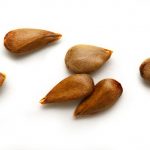
The wood apple (a.k.a. Kaitha) (Feronia limonia syn. F. elephantum, syn. Limonia acidissima L. Family: Rutaceae) is a thorny tree found in regions of Southern India, Sri Lanka, Bangladesh, mainly in the dry tropical or sub-tropical regions. It is drought-resistant and could even survive limited bouts of frost. The fruit tree is briefly described and reviewed (Radha and Mathew, 2007). The fruits taste sour and are good sources of riboflavin, niacin and a range of minerals. They are used in chutney, jellies and fruit drinks. A syrup is prepared by boiling pulp with its seeds and sugar. There appears to be some confusion over the species name and I’m keen to know whether there is more than one.
Uses Of Kaitha (Wood Apple)
Parts of the plant are used as a traditional treatment in India for a variety of conditions such as hepatitis, liver disease, asthma, cardiac arrhythmias and as a general purpose antiseptic. The fruit is more specifically and again traditionally claimed to have properties alleviating stomach upsets, cough, dysentry, and for treating bites.
Most parts of the kaitha plant have a broad spectrum of activities but the leaves may prove the most valuable. The stem bark is stated to contain antimicrobial components (Rahman and Gray, 2002) including marmesin (Jain et al., 2010), a novel pyranoflavanone, (−)-(2S)-5,3′-dihydroxy-4′-methoxy-6″,6″-dimethylchromeno(7,8,2″,3″)-flavanone amongst other coumarins, sterols, monoterpenoids etc. (Tiwari and Gupta, 1959). The roots and leaves provide a chromanone, imperatorin, bergapten and xanthotoxin (Intekhab and Aslam, 2009). There was some evidence for anti-tumour properties from a rhamnogalacturonan pectin (Saima et al., 2000) isolated from the leaves and for killing mosquito larvae – an insecticide (Rahuman et al., 2000). The volatile oil extracted from the leaf was characterised (Ahmad et al., 1989).
The fruit pulp was recently examined for its antioxidant and wound healing properties in a rat study whereby a methanolic extract was claimed to support the traditional therapeutic view (Ilango and Chitra, 2010). The fruit shells contain antifungal compounds such as psoralene, osthenol, xanthotoxin, 2,6-dimethoxybenzoquinone (Adikaram et al., 2007).
A team at the Institute of Chemical Technology, Matunga, Mumbai has used kaitha shell described as Feronia acidissima to adsorb dyes such as methylene blue and crystal violet. As with many ‘shell’ materials based on lignocellulosics, these afford a relatively cheap alternative to activated carbon in treating wastewaters heavily polluted with colour dyes or indeed other materials (Jain and Jayaram, 2010).
References
Adikaram NKB, Yamuna A, Lesliegunatilaka A, Ratnayuke Bandara BM, Kithsiri EM Wijeratne.(2007) Antifungal activity, acid and sugar content in wood apple (Limonia acidissima) and their relation to fungal development. Plant pathology, 38 pp. 258–265.
Agarwal, A., Siddique, I.R., Singh, J. (1989) Coumarins from the Roots of Feronia limonia. Phytochemistry, 28(4) pp. 1229-1231
Ahmad A, Misra LN, Thakur RS. (1989) Composition of the volatile oil from Feronia limonia. Planta Med., 55(2) pp. 199-200
Ilango, K. & Chitra, V. (2010) Wound healing and anti-oxidant activities of the fruit pulp of Limonia acidissima Linn. (Rutaceae) in rats. Trop. J. Pharmaceut. Res. 9(3) pp. 223-230
Intekhab, J., Aslam, M. (2009) Isolation of a flavonoid from Feronia limonia. J. Saudi Chem. Soc. 13(3) pp. 295-298
Jain, S. Jayaram, R.V. (2010) removal of basic dyes from aqueous solution by low-cost adsorbent: Wood apple shell (Feronia acidissima). Desalination. 250(3) pp. 921-927
Jain, M., Trivedi, A., Mishra, S.H. (2010) TLC Determination of Marmesin, a biologically active marker from Feronia limonia L. Amer. J. Plant Sci., 1 pp. 12-16
Manjusha, Patil K.M., Zambare, G.N., Khandelwal, K.R., Bodhankar, S.L. (2004) Hepatoprotective activity of aqueous extract of leaves of Feronia elephantum correa. against thioacetamide and allyl alcohol intoxication in rats. Toxicol. Int. 11(2): pp. 69-74
Radha, T., Mathew, L. Under and Un-Utilized Fruits. In: Fruit Crops: Vol. 3. Horticulture Science Series pp. 358-359. ISBN 81-89422-46-4
Rahman, M. Antimicrobial constituents from the stem bark of Feronia limonia. (2002) Phytochemistry. 59(1) pp. 73-77
Rahuman, A.A., Gopalakrishnan, G., Ghouse, B.S., Arumugam, S. Himalayan, B. (2000) Effect of Feronia limonia on Mosquito Larvae Fitoterepia, 71 (5), pp. 553-555.
Saima, Y., Das, A.K., Sarkar, K.K., Sen Sr., A.K., Sur, P. (2000) An antitumor pectic polysaccharide from Feronia limonia. Inst. J. Biological Macromolecules 27(5) pp. 333-335
Tiwari RD, Gupta RK. (1959) A note on the chemical examination of the constituents of the bark of Feronia elephantum. Curr. Sci. 28 pp. 213-214

Leave a Reply